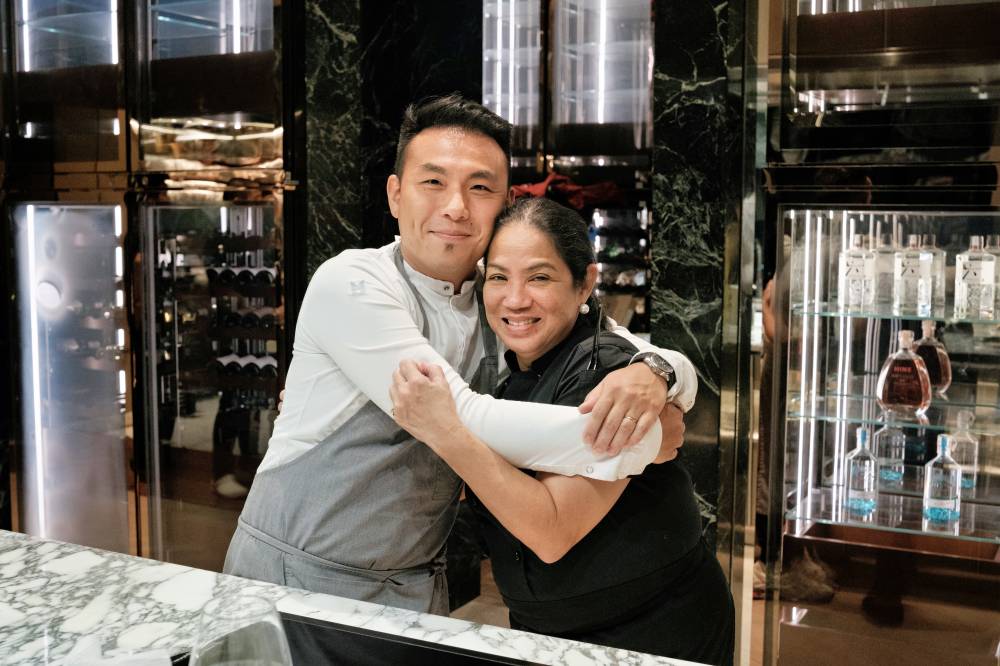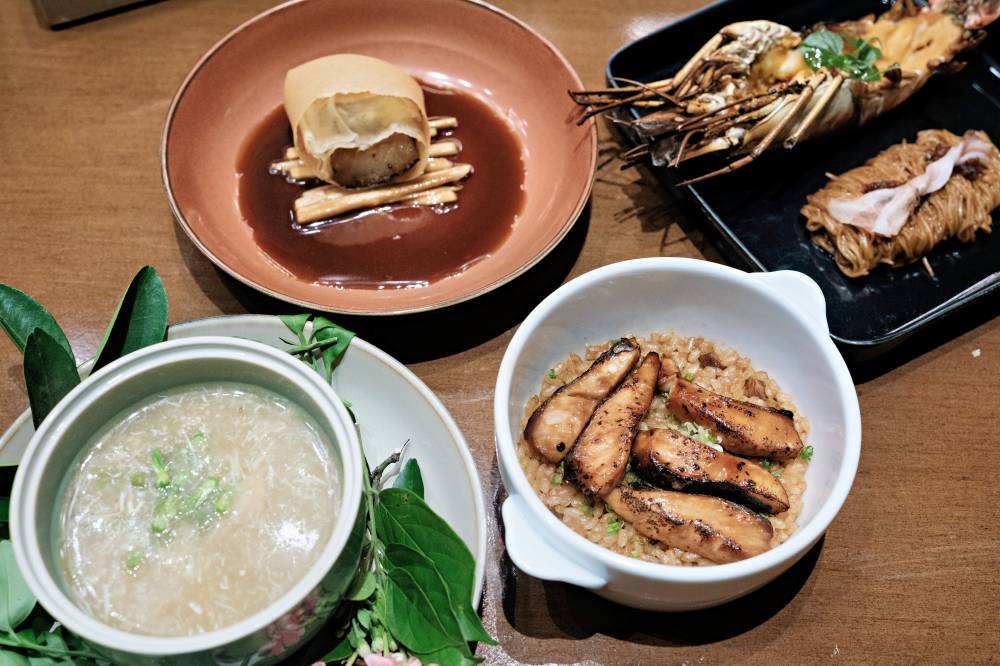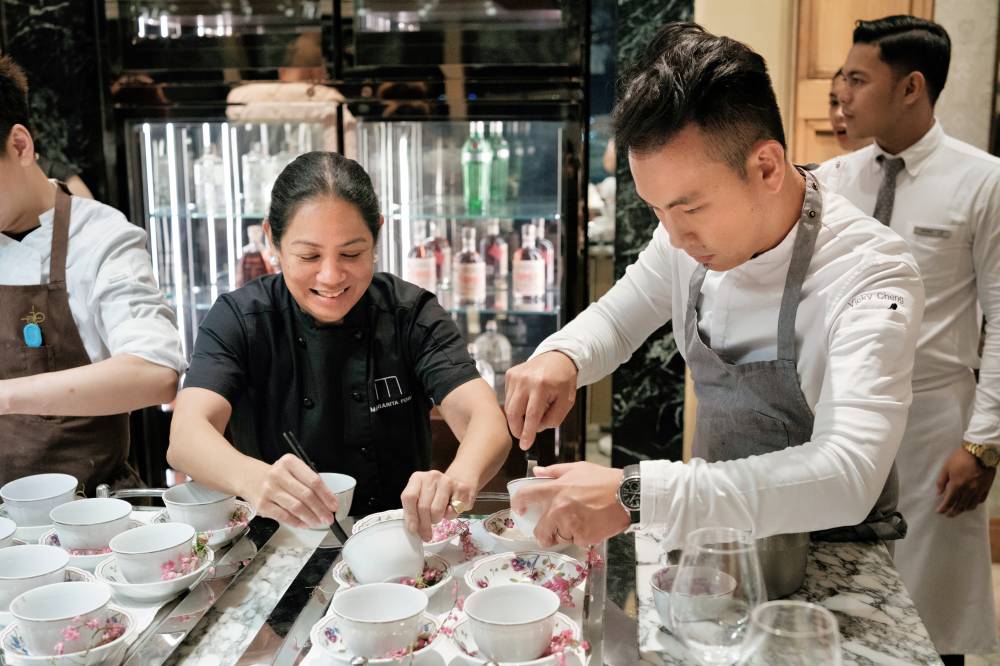Forés and Cheng: A collaboration of culinary titans

What do top chefs give each other? Ingredients, apparently. In the case of Margarita Forés and Hong Kong’s Vicky Cheng, it’s a couple of trays of kamias.
The souring agent was not used at the recent one-night-only “When Stars Align: A Four Hands Dinner and Culinary Showcase” at Penthouse No. 66, Grand Hyatt Manila, hosted by the Hong Kong Tourism Board. Hence, it was placed surreptitiously on the trolley on Forés’ side of the kitchen. However, it showed the friendship between the two top chefs and their eagerness to learn about each other’s cuisine.
Cheng excitedly shared how he’s going to preserve the kamias and work with them back home. He listened intently to the reporters who were giving him advice on how to use dried kamias on fish. This is how he approaches his craft in general—with great curiosity.
“I think that’s a big part of why we are successful. We are being recognized because I am always excited,” he said.
Cheng is the owner of the Michelin-starred, French Chinese restaurant Vea. Recently, his second restaurant, Wing, earned the no. 20 spot in the The World’s 50 Best Restaurant rankings. The title motivates his team to work harder. He brought the same team with him to Manila.
Cheng was born in Hong Kong but raised in Canada, hence the French influence. He fell in love with Chinese cuisine because of Vea.

“It’s a French restaurant but it carries a lot of Chinese ingredients, recipes and stories,” he said. “I have to incorporate a lot of ingredients that I didn’t know what to do with, and make them French.”
Cheng said that a lot of Chinese ingredients were familiar to him because of his heritage. It’s recipes that he saw as a child, but he didn’t really know how to use them. He learned by failing multiple times.
“I have to learn how to cook (a dish) in a traditional way first. Every time I succeed in making Chinese food, I ultimately throw it away because it has to be French,” he said.
It meant making the same dish at least 10 to 15 times before he was satisfied. The practice taught him the value of failing and exploration.
Ambassador of dried seafood
“Learning how to cook is not rocket science, If you want to cook, you will learn how to cook. It’s just how much you want to learn,” he said. “You have to accept the fact that you’re going to make a mistake, you are going to lose and you are going to make things that make you unhappy.”

Cheng kept studying and working until he found a niche in the culinary world. It’s what made his restaurants stand out from the rest. Forés refers to him as the face or ambassador of hoi mei or dried seafood.
It’s easier said than done. He candidly talked about how learning about them meant starting with buying authentic ingredients without being tricked or fooled. Simultaneously, he studied how to bloom or rehydrate them and finally, how to cook them.
“I thought that I must conquer the Chinese dried seafood because that’s the caviar and truffle of Chinese cuisine,” he said. The ingredients he liked to work with included sea cucumber, fish maw and abalone.
The amuse-bouches at the showcase featured two from each chef. Cheng’s first offering was the Golden Crystal Egg, which his kitchen prepared for two months in Hong Kong. The eggs whites were clear and not black like the common century eggs from supermarkets. It was also devoid of the ammonia flavor often associated with century eggs. The yolks were creamy and runny. It was the topper for the hand-pulled noodles with mala chili sauce. Cheng also came up with the Smoked Eggplant with Sour Sauce, for which he took inspiration from his two daughters’ hairstyles. He braided the vegetable in their honor.
Forés offered Ukoy Malasugui Kinilaw, which was a reimagined ukoy of her youth. It was one of the staple orders her grandparents shipped from Negros when they had an event. It would arrive on wax paper and still be crispy.
She tried searching for an artisan who still makes it that way and found one, who refused to share the process with her. Thus, Forés tried reconstructing it using shrimp batter, which was deep-fried to make crumbs and form a patty.
She marinated the blue marlin with tuba, tabon-tabon from Butuan and biasong (lime).
“Tabon-tabon is supposed to protect our stomach from raw fish. It makes the kinilaw safer, and it adds the bitter aspect we find in our cooking,” she said. Cheng brought fish roe for her, which she also used in this dish.
As a nod to Cheng, Forés served Banana Heart Salad with coconut milk, corn and Bohol fish maw as a palate cleanser.
“The fish maws in Hong Kong are big and they come from Africa and South America. We do have fish maws here, but ours are very tiny, just like us Filipinos,” she said with a laugh. Her fish maw came from abo fish and was deep fried. It could pass off as chicharon, adding texture to her snack.
Like a warm embrace
Forés and Cheng first met in 2017. She was named Asia’s Best Female the year before, and Vea just earned its first Michelin star. Cheng hosted their party in Hong Kong, and she said that he makes the best staff meals.
“It was one of the best learning experiences for me and one of my happiest Hong Kong experiences as well,” she said. She collaborated with him again in 2019 in Manila for an eight-hands dinner.
“I think the 2024 experience was like a warm embrace that I was able to cook with him. He is one of my idols. No trip is complete without reserving a table at Vea. We’ve become really close friends,” she said.
They saw each other last month in Cebu when he was named United Nations’ ambassador for gastronomy tourism, joining her in the roster. Cheng came with his family, and they ate Cebu lechon together.
For the first course, White Pepper Virgin Mud Crab Thick Soup, tonkin jasmine was included in the dish—a common ingredient for Cheng but a discovery for Forés. She was able to source it locally, and found out that it was being used in pinakbet in Pangasinan.
Forés prepared Bulacan River Prawn with Etag XO for the second course. The grilled prawns were made decadent by crab fat that looked like melted butter. To balance its richness, it came with noodles mixed with Etag XO, taking inspiration from pancit canton. The noodles came from Cheng.
Cheng served Sea Cucumber Spring Roll next, which is one of Wing’s signature dishes. He put a Filipino twist in the dish by adding julienned palm hearts that added to its crispness.
The finale was Pili Nut Hojaldres and Mochi, which featured both chefs’ work in one plate. Forés’ hojaldres came with cream filling and surprise candied guava and tomato. The two chefs talked about how the search for the perfect mango for Cheng’s mochi had him tasting from at least 80 sources before settling for the one from Cebu.
The one-night only affair ended with the two chefs hugging, very much like the food they prepared that evening.

















